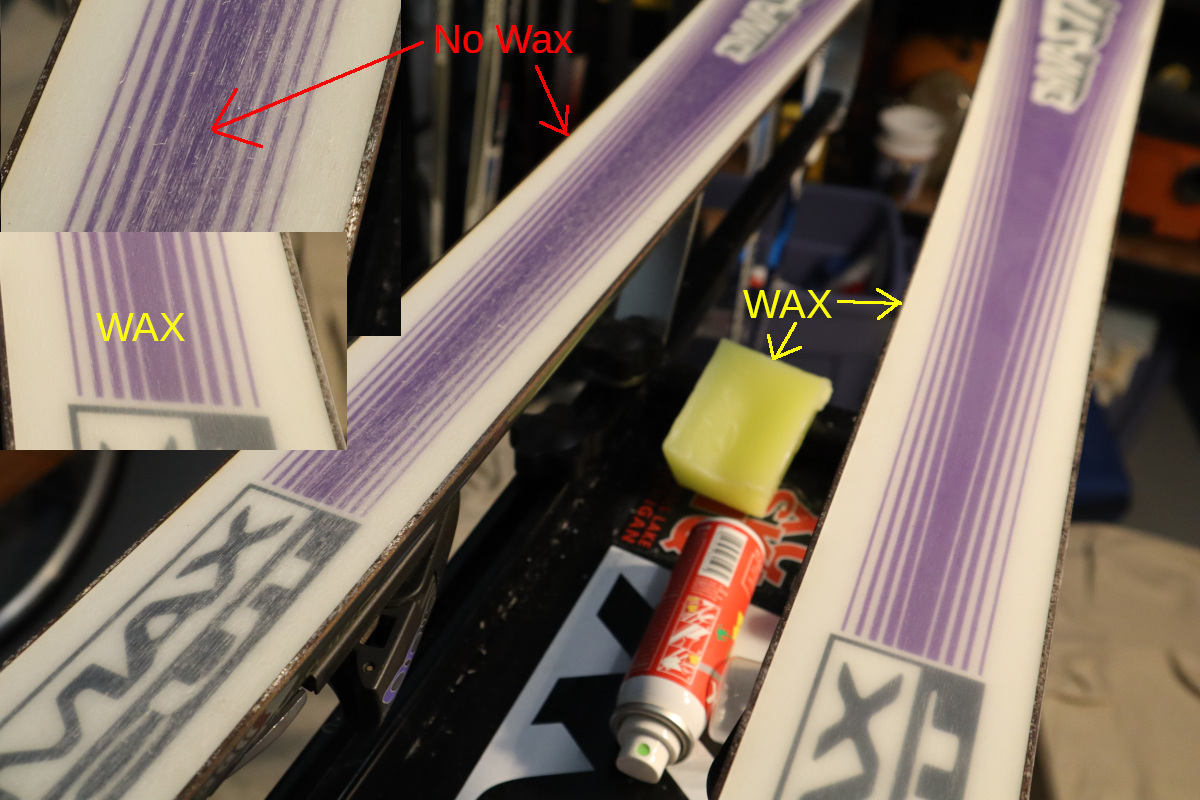Downhill Wax
:date: 2024-04-22 13:30 :tags:
Today I was prepping my (Nordic) skis with summer wax; I'll refrain from delving into what that even means. However I recently came to possess some very used Alpine skis and looking at their bases made me want to make a little PSA for the motorskiers I know.
If you own skis that only are supposed to go down mountains, do you need to wax them? In my opinion, yes. Take a look at these skis where I have just waxed the one on the right.

I would not be surprised if this is their first wax since being new. I thought this was an interesting shot to illustrate what it looks like when the bases are absolutely stripped and dry.
Ok, sure it looks like wax changes the look of the bases, but is that really important? Consider the following. Oiling the chain on a bicycle is not optional; if you don't do it eventually it will become painful to pedal. However, never oiling the chain on a motorcycle won't ever make you sweat more. But leaving a motorcycle chain dry will cause squeaking, rattling, vibrations, and terrible gas mileage. It is unsafe and basically a terrible idea.
You may think that since you're not a downhill ski racer that you don't need to go fast, and so you don't need properly prepared bases on your downhill skis. Perhaps you think the more friction you have, the better it is for not zooming out of control into a tree. Or something like that. Unfortunately it doesn't quite work that way. By skiing on dry skis with all wax totally worn off you're going to have a lot more problems with control and predictability. The skis will subtly stutter and create stability problems. With smooth sliding skis you'll be able to slip predictably into turns that can keep things under control with less effort.
Just like anyone who regularly rides a bicycle appreciates chain lube in the same way that elite professional motorcycle riders do, so too do all Nordic skiers appreciate ski glide like elite professional Alpine skiers. After a lot of very personal blood, sweat, and tears relating to ski wax I can offer some tips.
I think that for normal people (e.g. no more skiing power than me) you can count on about 50km of good skiing with a wax job. I think that 100km is ok skiing but getting worse, and beyond that things start to fall apart and get very bad quickly. Also the first 1km or so after you get your skis waxed can be the worst 1km. This is probably less of a problem for Alpine skiers who can use the motor/gravity to press through this, but if that first run feels terrible, check again on the second run.
Another thing to note is that switching ski sides is helpful. When you start wearing down the wax, you'll see the dry rough p-tex (as in the comparison photo) start to appear in the areas you generate the most friction. By switching sides you can get a lot more life out of the wax.
Also without getting too nerdy about wax, we all kind of know what wax is and we know that if someone puts, say, a candle or a crayon in a hot car that it will likely make a mess. That ordinary intuition will serve you well if you remember that there is a microscopically thin layer of delicate wax on your skis and avoid situations like leaning them up against the heater in your hotel room, etc.
I actually am not an expert at all on exactly what Alpine skiers (or snowboarders) should do but it probably is very close to what I'm fastidiously doing with my Nordic skis: 1. Clean with a base cleaner to get dirt, sap, and other contaminants out. 2. A base prep wax applied with a ski wax iron; scrape that out hot and it will pull out more impurities and gunk. 3. A layer of harder wax; scrape cold. Then a layer of warm temperature wax (unless you know where global warming isn't in effect), and scrape that cold. 4. Finally brush with bass, horsehair, and nylon brushes in that order.
Or do whatever the folks at the ski shop suggest. But what you don't want to do is be oblivious to the fact that all ski bases need glide wax applied from time to time because it does wear off. Take it from someone for whom every skiing watt is meticulously conserved, the difference between skiing with and without proper wax is really the difference between skiing and melting snow by strapping boards to your feet.